

































































By Paul Kimball
On March 6th to 9th, the town of Alida was home to ‘Don’t Tell Mother’, a two-and-a-half-hour comedy written by Monk Ferris. This was the 29th play that has been staged by Alida’s Act One Productions, a concept started back in 1992.
That year, an addition was required for Alida’s Community Hall. The idea emerged that money could be raised by presenting a play. The idea went over so well that it has continued every year since then, with the exception of a ‘hiccup’ during the COVID years.
Most years, the plays generate about $15,000. The beneficiary

of the proceeds is the Alida Rec Board to use for whatever projects or upgrades they have on their things-to-do list.
This year, Thursday and Friday were ‘cocktail nights’, featuring drinks and appetizers. Saturday’s show was a dinner theatre and Sunday was a matinee, with cookies and refreshments for the audience. Friday’s and Saturday’s shows were sold out, with 128 in attendance, while Thursday’s show was about three quarters full.
Tim Cowan is the president of Act One Productions and a co-producer of this year’s offering. He is also one of the actors. In fact, this year marked his twenty-sixth year acting in
a play. He indicated that a show like this takes a lot of work from a lot of volunteers. No one is paid...not the actors, nor the production crew or any of the behind-the-scenes workers. Some have been involved for many years, including Shanna Carriere who has acted for 25 years and Wes Smith, who is on stage for the tenth time!
The process started this past November, when a handful of plays were considered. After one was chosen, eight actors were selected, and the first practice took place just before Christmas. Once the calendar page turned to January, practices took place twice a week and then, come February, that was ramped up to
three per week. As March neared, practices took place daily.
A far cry from being one of those ‘improv plays’!
Others volunteered to help out in non-acting ways. Dishwashers, producers, set designers and builders, costume creators, directors, those preparing meals – a small sampling of all that was required!
Cowan was thrilled by the community involvement! “It takes a whole community to put something on like this”, he said. “So many volunteers, all out of love for their community of Alida. The actors may get all the recognition at the end, but there are so many others that need to be acknowledged!”























Sat, Mar 15 – Arcola High House – The Leftovers
Tues to Sat - Mar 25 -29 – 125th Arcola Curling Club Bonspiel
Your rst stop to nd events happening in our community!
Sat, April 12 – Lions Supper and Auction
*Do you have a community event you want listed here? Send us the name of the event, date, and what community it’s being held by emailing: observer@sasktel.net OR calling: (306) 453-2525.
By Paul Kimball
It is really interesting how stories can emerge out of things that weren’t supposed to happen! Take, for instance, the events of this past fall. On November 25th and 26th, the Saskatoon Blazers were scheduled to travel to Estevan to play a couple of games against the Bears. Those two teams play in the SMAAAHL (Saskatchewan Male AAA Hockey League). Those games were forced to be postponed, as a winter storm prevented the Blazers from getting out of Saskatoon.
When time came for those rescheduled games to be played, no ice time was available in Estevan. A back-up plan saw the games shift to Oxbow and were played on February 26th and 27th That’s where the interesting story unfolds. On the Blazer roster was a player named Troy Shewchuk, whose hockey career path would likely have never taken him to Oxbow. When Troy stepped onto the ice, he became the fourth generation of the Wright family to play organized hockey in Oxbow’s arena. That ‘family trail’ be-
gan way back in 1960. The hockey league now known as the Big Six started that year with four teams – Carnduff, Oxbow, Glen Ewen and Bienfait. Playing for the Glen Ewen Eagles was an exceptional player by the name of Lyle Wright. Just to give you an idea of how good Lyle was, he won the scoring title in 1962 with 90 points in just 16 games! Another example of his playing prowess was seen in 1953, when he was with Carnduff ’s Junior B team. In a game where Carnduff was winning 15-1, the coach asked Lyle to ‘hold things back’


a bit…as Lyle had scored 14 of the goals. Lyle responded by saying that he wasn’t wired to play at half-speed!
Lyle had a son – Rae. Years after Lyle made his Oxbow Arena debut, Rae made his, playing for the Huskies in the same Big Six that his dad had played in. Rae was a pretty good player himself. He didn’t play organized hockey as a kid, only skating in shinny games on dugouts and playing recreationally. He was 31 when he played his first organized game with the Huskies. Perhaps his biggest claim to fame was the evening when he scored 2 goals and had 5 assists against the Lampman Imperials…and still didn’t win ‘player of the game’ honours. That went to his linemate who scored 5 goals…all set up by Rae! The trail continued. Rae had a daughter named Kyla. She played 7 years on Oxbow ice, skating with the boys. In fact, some years she was the only female player on the team. At the age of 13, she moved to Moose Jaw with her mom and that brought her Oxbow playing career to an end. She eventually moved to Saskatoon and in time, gave birth to a future hockey-playing son named Troy.

Four generations of Wright’s on the ice at Oxbow arena. Lyle, great-grandson Troy, granddaughter Kyla and son Rae. Photo courtesy of Rae Wright
And Troy kept the ‘Wright streak’ going when he laced up his skates in Oxbow on February 26th
All because games that were supposed to be played in Estevan weren’t…and games that weren’t supposed to be played in Oxbow were! It will be interesting to see what twist of fate will enable a fifth generation of Wright’s to keep the streak alive!



Submitted
by:
Michelle Busa, Jim Pattison Children’s Hospital
From the beginning of his life, 10-year-old Blaze Dunn from Carlyle, has overcome many physical challenges, but he hasn’t let anything dampen his positive spirit. His “be strong, never, ever give up” attitude has helped him through eight different surgeries for bilateral club feet, strabismus, as well as a tethered spine, and a life-threatening accident.
In August of 2022, Blaze was in a vehicle accident, breaking his humerus and femur. After a series of x-rays, Blaze was airlifted by plane to Saskatchewan’s Jim Pattison Children’s Hospital (JPCH) receiving critical care from the only Pediatric Intensive Care Unit in Saskatchewan. It’s been a long recovery after his surgery, but his family is grateful for having JPCH in our province and for being able to stay in Saskatchewan for his treatment.
“The care we received was amazing. A children’s hospital is vital in our province. Without it, I am not sure where Blaze would have been sent. He got the specialized care he needed close to home, in a fantastic facility with a stellar team,” Blaze’s mom CaroleLyne said.
His optimistic attitude towards the endless challenges he has faced, along with the

incredible care he has received at JPCH, drastically improved his recovery. Blaze has now become passionate about giving back and being an advocate for JPCH, raising over $75,000 through a variety of fundraisers in and around Carlyle. In recognition of his commitment, he received the 2023 National Philanthropy Day Outstanding Youth Philanthropist award, nominated by Jim Pattison Children’s Hospital Foundation.
We are honoured to an-


nounce Blaze as the 2025 Saskatchewan ambassador, representing Jim Pattison Children’s Hospital Foundation (JPCHF), for the Children’s Miracle Network Champions Program.
“We are excited to announce Blaze as this year’s Champion Child, representing sick and injured kids across Saskatchewan. Blaze’s compassionate spirit and resiliency are inspirational to everyone he meets and we are honoured to have him in this role,” said Jada
Kook, Community Engagement Manager at JPCHF.
Through the Champion Program, Blaze and his family will get the opportunity to travel to Orlando, FL. this spring to represent Saskatchewan families at Children’s Hospitals Week and meet other child ambassadors from across North America.
Jim Pattison Children’s Hospital Foundation wants to thank Kherington who passes the role of Champion Child to Blaze. Kherington has been



an outstanding ambassador for the Foundation and did an incredible job sharing her medical journey across the province.
About Saskatchewan’s Jim Pattison Children’s Hospital Foundation
Saskatchewan’s Jim Pattison Children’s Hospital Foundation is dedicated to raising funds for the enhancement of maternal and children’s health care in Saskatchewan. Our Foundation’s mission is to inspire philanthropy for Saskatchewan to drive transformative maternal and children’s health, research, and innovation through Jim Pattison Children’s Hospital and programs throughout the province. For more information, please visit pattisonchildrens.ca.
About Children’s Miracle Network
Children’s Miracle Network® raises funds and awareness for 170 member hospitals, 13 of which are in Canada. Donations stay local to fund critical treatments and healthcare services, purchase pediatric medical equipment, and support research. Its various fundraising partners and programs support its mission to save and improve the lives of as many children as possible. Visit the Children’s Miracle Network website to learn more about its cause. In Canada, Children’s Miracle Network is managed and operated by Canada’s Children’s Hospital Foundations®.

Stephanie Zoer
Just a few words
I was raised on a dairy farm in southern Ontario. Back in the day it was considered a fairly large operation with 36 milking cows.
As early as I can remember I went to the barn to help as I loved the farm life.
In the summer they were kept on pasture and in the winter, they stayed in the barn.
I always enjoyed feeding the calves and bedding down the cows and in the summer hopping on my horse to herd the cows in for milking.
The winters did not get as cold as they do in Saskatchewan, but we did get some nasty storms causing some grief.
This winter has been a roller coaster for farmers. One week it is in the single digits and the next week we are fighting -40 degree Celsius wind chills.
I have a friend who owns a horse ranch and has many boarded horses. In the cold snap her water bowls froze.
Out of the blue, I asked her how she was doing with the cold, meaning, are you okay, as she lives alone.
She said, “Don’t ask,” and then proceeded to tell me she had to water the over 30 horses by hand until she could figure out how to solve the problem.
She and her mom are very crafty people, and they resolved the problem to a certain extent, but my hat goes off to them, having to do this in the -40 degree Celsius temperatures.
Not living on a farm anymore, I have the choice to stay in my warm toasty house or to venture out.
A farmer does not have that choice when they have live stock to feed, water, and bed down.
The wind that we have had also creates drifts in the fields, another issue the farmer has to take care of.
When the drifts get too deep, the farmer may blow a path for the cattle to go down and this may also be the place where they will unroll the large bales of hay and straw for them to bed down on.
In the cold temperatures the farmers need to make sure their equipment will start. In my day we could feed small square bales, after all it was only a small herd, but the farmers that have a large head of cattle to feed, it is difficult if the tractor will not start.
Most of the farmers here do not have a barn big enough to house all the cattle in a storm, so they need to be prepared in other ways. They have shelters that block the animals from the wind.
It is also getting closer and closer to calving season, and I am sure some have already started.
They need to watch their herd and see who is getting close, so if a pending cold front or storm is blowing in the expecting cows can be brought in to the barn for a closer watch and more shelter.
Nope, I sure do not envy a farmer during those cold snaps, but I do not envy them either when we get this sudden heat wave.
This creates another headache for the farmers. While the snow is melting into slush it causes a mud path for them to drive through and sinking into the deep slush.
Most farmers care for their animals very well, after all this is their bread and butter.
I know that being a farmer is the profession that they have chosen, but this does not mean I do not feel bad for them when the weather works against them.
It is because of farmers that we have many of the things that we can purchase in the store or buy from them directly.
So, my hat goes off to the farmer when the weather is not at its best.
“A winner is a dreamer who never gives up.”

Where we were and what we were doing

It was Thursday, March 12. My husband and I had tickets to “Celtic Illusion” in Saskatoon—a show featuring Irish singing, dancing and magic. We were looking forward to it but spent the day waiting for it to be cancelled. As the afternoon wore on and there was no such announcement, we began wondering if we should just stay home. Oh, did I mention it was March 12…2020?
The night before, the NBA suspended their season. The next day the NHL announced a pause. Dominoes were tumbling fast as event after event was suspended. But no announcement about the show, so we went. I would likely make a different decision today but at the time we were barely past the starting line in learning how a pandemic was going to affect the globe.
On March 24 the announcement came that there would be no Olym-
pics that summer. They were jumping the gun, I thought. Oh, how little I understood at first. But we all became far more knowledgeable about infectious disease, methods of transmission and contact tracing as we listened to daily numbers and learned where COVID was spreading.
In some ways it seems so long ago. Something will spark a memory of being six feet apart, wearing masks, and becoming accustomed to holding online meetings. In other ways it is still so fresh. Often I find that when I think about a timeline of recent events I ask,” Did that happen before COVID or after?”
Significant moments stand out for me. First was the loss of a dear friend, Laurie. I shared at the time that although her death was not COVID-related, the marking of it certainly was. There was no funeral we could attend in May 2020 so we gathered family members on a beautiful afternoon in our backyard where our pastors led us through a service for her. I have since thought about all the families lined up outside cemeteries in Italy. They were given only 10 minutes to have a time of burial and then had to leave so the next family could come in.
Christmas Eve that
first year was in our homes with gatherings no bigger than five people. My mom was living in Abbotsford at the time so we joined households on the phone, held our candles and sang “Silent Night” together.
How different it had been the previous Christmas when not only had she flown in to spend the holidays with us, she made plans to move here. A few months later those plans were shelved when the real estate industry completely shifted. Thankfully, she was able to make the move the summer of 2021.
With summer plans curtailed because of travel restrictions we made an effort to see things closer to home. My family reflected after visiting Shiloh, the first Black settlement in Saskatchewan; pondered the history of Pine Island; took our pictures at the Eiffel Tower in Montmartre; marvelled at the Opera House and architecture in Wolseley; walked through churches constructed of stone; and had picnics in lovely parks we didn’t know were there until that day. We were forced into our own provincial backyard and that was a good thing for me.



It has been five years since those first pronouncements started changing how we worked, gathered, worshipped, shopped, celebrated and travelled. In the years since, some returned to life as they knew it. Others had to search for new jobs and new places to live. Still others suffer losses they carry with them --loved ones lost to the virus; health that simply isn’t returning; and doors that remain closed.
Much became apparent during it all: the importance of connection, the need for face to face conversation, the preciousness of family, and the benefit in not getting over-scheduled. While we were instructed in how to social distance, sanitize and keep ourselves safe, five years on the former are the lessons that matter most. That’s my outlook.
But of course we remember the many difficulties faced during that time. Isolation, anxiety, loss of income, changes to weddings, graduations and other long anticipated events; challenges in getting an education, and the closure of businesses. Families were now spending a lot more time together due to lockdown. While it was an opportunity to strengthen bonds for some; others found it to be very painful, particularly if spouses disagreed on vaccinations, adhering to restrictions or if there had been job losses. The dissolution of relationships was the fallout.





















By Kaitlynn Nordal
Those interested can celebrate with a free tree from the local library this Earth Day from Neighborhood Forest.
Neighborhood Forest is a non-profit, social venture dedicated to giving children a tree to plant on Earth Day for free every spring.
“We love trees. We love planting them and watching them grow. We want to give every child this joy,” said Vikas Narula co-founder of Neighborhood Forest
The program helps beautify neighbourhoods, remove carbon from the atmosphere, and help instill a sense of magic, wonder, and love for our planet for those who participate.
Since 2010, Neighborhood Forest has mobilized over 3,500 schools, libraries, and youth groups, engaged over 500,000 volunteers, and given over 197,000 children in all 50 states, Canada, Mexico, Ghana, and Haiti the opportunity to plant trees.
“We are on track to give over 100,000 kids their very own tree this Earth Day,” said Narula. “Up from 67,000 last year.”
Neighborhood Forest is growing at a rapid rate and is aiming to reach one million children in the next few years.
“Our dream is to reach every child in North America and eventually the world,” said Narula.
Neighborhood Forest is one of the largest and fastest growing tree planting initiatives in North America that is free and volunteer-driven, coordinated on an annual basis every spring, focused on urban and residential beautification, and involves

hundreds of thousands of children and families.
Those in the Southeast Regional Library organization first heard about Neighborhood Forest in 2024 and did it that year.
“We saw that another regional library in the province was taking part so we reached out to the organization,” said Morgan Kelly the Community Services Manager for Southeast Regional Library.
They asked for more information about how to participate and then made every branch a place to sign up for the program.
“The program took off,” said Kelly.
“We have tried to reach out with partnerships the last couple of years but we have never done a giveaway like this,” said Kelly.
“It’s not something you think of when you think of the library,”
continued Kelly. “You don’t think of free trees. So, it was a good way to get people who hadn’t even been to the library interested. Then we were able to offer more resources or programs and interest them now that we have them.”
In 2024 they did al-
most 1,000 trees. “We were surprised with how well it went. That was a big thing for us. We have a lot of different resources and of course, we are always trying to get more people to use their libraries and trees seem to be a big draw. We couldn’t
NOTICE OF ASSESSMENT ROLL PREPARATION
Town of Carlyle
Notice is hereby given that the assessment roll for the Town of Carlyle for the year 2025 has been prepared and is open to inspection in the office of the assessor from:
MONDAY TO FRIDAY
9:00 a.m. to 4:00 p.m.
March 6, 2025 to May 7, 2025
A bylaw pursuant to section 214 of The Municipalities Act has been passed and the assessment notices have been sent as required.
Any person who wishes to discuss the notice of assessment or potential appeal may contact the assessor at the Town of Carlyle, Box 10, Carlyle, SK S0C 0R0.
Any person who wishes to file an appeal against their assessment is required to file a notice of appeal accompanied by the $30.00 with: Nicole Hoskins, Secretary of the Board of Revision, Western Municipal Consulting Ltd. Box 149, Meota, SK S0M 1X0, by the 7th day of May, 2025
You may also access property assessment information using the SAMA online database, known as SAMAView SAMAView provides public access to search, view and compare individual property assessments in all SAMA’s client jurisdictions Access is free of charge for non-commercial users. Visit SAMAView to create an account or sign in to search for property assessment information www.sama.sk.ca/property-owner-services.
Dated this 6th day of March, 2025.
believe the take-up. It’s a great idea. For some reason it clicked with people,” said Kelly.
Since it is not over for 2025 Kelly is unsure how many they have done.
“I don’t think we are there yet but I know some of the bigger branches will have 30 people signed up,” said Kelly. “Some of our smaller ones will have anywhere from 10 to 20 signed up. It depends on the community.”
Kelly thinks this is a great addition to their Earth Day programming.
“Our branches do a bit of programming around Earth Day but this is an opportunity to provide something we would not normally be able to make happen,” said Kelly. “We are lucky to work with Neighborhood Forest because there are a lot of donors and fundraisers that make this possible for all of North America.”
“We are trying to work on programs that get people thinking outside the four walls of the library. This is an interesting program for us this gets people think-

ing about the ways the library supports their community beyond books,” continued Kelly.
Neighborhood Forest aims to provide native and /or fruit-bearing trees in all the regions they serve.
“We mix up the species each year on a state-by-state, province-by-province basis. We will know the exact species for Saskatchewan in early April,” said Narula.
Parents have until March 15th to order a free tree. Parents and guardians can sign up their child at the local library or online.
“There is no limit (to how many families can sign up) so if you want to sign up you are more than welcome to,” said Kelly.
Parents and guardians can pick up their trees from the library right around Earth Day (April 22). Parents and guardians should check updates from the library via email or social media to find out exact pick-up dates/times. If trees are not claimed by the end of April they will be given to others on a firstcome-first-serve basis.








Natalie Miller Assessor
Prairie Pride Credit Union is seeking to elect Board of Directors for the following branches:
• 2 Directors at the Alameda Branch (2 & 3 year terms)
• 1 Director at the Alida Branch (3 year term)
• 2 Directors at the Gainsborough Branch (1 & 3 year terms)
Nomination forms can be obtained from any staff member at Prairie Pride Credit Union or from a member of the Nominating Committee, wherever an election is required. Full eligibility criteria are provided on the reverse side of each nomination form.
Nominations must be received by Prairie Pride Credit Union no later than 4:00p.m., Tuesday March 18th, 2025. Election week has been established as April 10-18, 2025 inclusive.



By Stephanie Zoer
Many curling rinks are coming close to their season ends and several will be hosting a fun day, and this included Arcola.
This is the second annual glow in the dark funspiel that Arcola has held, and it has become a popular event, especially for the kids.
Twelve curling teams came out on March 8 to the Arcola Curling rink
to have some fun in the dark.
With the lights turned down and black lights set up the glowing began with the glow in the dark games.
According to Warren Neuman over half of the players were kids and they had a blast. There was no keeping score, as it was a funspiel, so everyone became winners, and everyone went home with a prize.






Teams came from Carlyle, Oxbow, Redvers and the rest were local teams, but they all came with the attitude to have a great time.
During the day the kitchen offered homemade foods such as soup, chili, sandwiches and pulled pork, with baking to follow for dessert.
dark face paint and glow sticks and anything fluorescent glowed.
Curling will come to an end this week in Arcola with league playoffs and then the brooms will be hung up and the ice taken out.
Next year will be a busy season for the Arcola Curling club as they host the 64 team bonspiel for their 125th anniversary.


Steel Reef donated a Hardline curling broom, which was offered in a Loonie raffle. Ella Neuman was the lucky winner. Kids had glow in the
They look forward to hosting this event but will also host another glow in the dark funspiel just for fun.


























By Stephanie Zoer
It was a tough week for the Carlyle Cougars U15 and U18 teams as they played their first games in the South finals in the provincials.
The U15 Cougars travelled by bus to the north to meet the Lumsden Lions for an afternoon game on March 8 for game one of the South finals.
After the U15 Cougars took down Moosomin in round one and Canora in round two, they were averaging 6.5 goals per game, while holding their opponents to just 2.75.
Now they have their sights on Lumsden, but this game did not go quite as they had planned.
After three hard periods of playing hockey, the Cougars fell short losing 5-3.
The U15 team will play in Carlyle on March 15 at 2 p.m., and they are looking for fan support.
This is a do-or-die game for the Carlyle team, and if they win, this will bring the series to a tie and into the modified third game, right after the second game in Carlyle.
If they lose, their hockey games will be done for the year.
As for the U18 Cougars, they played on March 9 in Carlyle. It was also an afternoon game, and attendance was near capacity, as they played off against the Lumsden Lions in game one of the South finals.
Only seconds into the game Cougar’s captain Jaden Fischer shot one past Lumsden’s goaltender. This sent the crowd into an uproar.

Standingready
Into the second period Lumsden had two quick goals giving them a 2-1 lead.
By the third period Carlyle was outshooting Lumsden 24-15, and later in the period they tied up the game.
With just over two minutes remaining in the game, Lumsden scored once more, and held on for a 3-2 win.
The next game will take place in Lumsden on March 15 at 2:30 p.m. This is also a do-or-die game for the Cougars.
Next weekend will be a tell-all weekend on whether the two teams move on to the championship or whether they plan for next season.

Full Gospel Church Welcomes You
202-4th St W.
Service Schedule: Sunday morning Service 10:30 a.m.
Jesus Still Heals Today Wed. evening Bible
Study 7:30 p.m 306-453-2512
Pastor Rodney & Gail Cox
Roman Catholic Oxbow/Cantal/ Carnduff Father Leonardo Tamayo Oxbow St Joseph’s
Church of Our Lady, Carlyle Father Chris Juchacz
Carlyle: Sunday at 11 a.m.
Kenosee: Saturday at 5 p.m Forget: Sunday at 9 a.m. 306-453-6200
Carlyle United Church 202-2nd St. W. Sunday Services: 10:00 a.m.
CL OS ED JU LY & AU GU ST *** Ph: 306-453-6136


Arcola-Kisbey United Church Worship Times: 10 a.m
KISBEY: 1st & 3rd Sunday
ARCOLA: 2nd, 4th & 5th Sunday
Please join us for worship



TENDERREQUIREMENTS
Bidders
rm.04@myaccess.ca
Tenders must be submitted in the prescribed form and must be
The depositshall be made by way of acertified cheque,bank draft, or money order
successful bidder(s) will have 30 days to provide the payment in-full to
bidder doesnot finalize the agreement for sale within 30 days.
Tenders must be submitted in asealed envelope addressedto: RuralMunicipality of Coalfields No. 4 TaxTitle Property Tender PO Box 190, Bienfait,SKS0C 0M0
Tenders must be received by 4:00 p.m. on April 14, 2025. Highest, or anytender,not necessarily accepted
Forfurther information contact the undersigned.
Dated this 13th day of March, 2025. Monica Kovach, CAO 306-388-2323 ext. 4






































































































































































Theresa (Teri) Busse 1948 - Jan 19, 2025
Teri was born in Wadena to Hage and Ted Paulson. Her husband Stuart Busse (of Eastend) and daughters Susan and Leah lived in Biggar, Saskatoon, and at their Turtle Lake cabin.
Teri was a trailblazer with Canadian Scholarship Trust Plan RESP. Full obituary at TheStarPhoenix.com.
Bryden Construction & Transport Co. requires SHOP LABORERS
Duties involve cleaning the shop and equipment, assisting in the service/ maintenance area, and general laborer duties. Clean driver’s abstract required. Job location is Arborfield, Sask. Room and board provided. Send resume with work references to: brydenconstruct@ xplornet.ca or fax 306-769-8844

HIRING: Person to COOK & CLEAN for heavy (road) construction camp this upcoming season. Current location is near Saskatoon, SK. Must have valid driver’s license and safe food handling ticket. Experience in camp setting with 20-30 crew, an asset. Send resume with two work references to: Bryden Construction, Box 100, Aroborfield, SK., S0E 0A0 brydenconstruct@ xplornet.ca or fax 306-769-8844 www.bryden constructionand transport.ca
Advertisements and statements contained herein are the sole responsibility of the persons or entities that post the advertisement and the Saskatchewan Weekly Newspaper Association and membership do not make any warranty as to the accuracy completeness truthfulness or reliability of such advertisements For greater information on advertising conditions, please consult the Association's Blanket Advertising Conditions on our website at www swna com Find QUALIFIED LOCAL EMPLOYEES using the strength of community newspapers! Visit www swna com or call 306649-1405 to find out how!

and forage great
reSiStance 1St NitrogeN uSe efficieNt cereAl iN cANAdA
AttrActiNg JApANeSe iNtereSt cerveza, cdc auStenSon, cdc maverick, Sundre wheAt Pintail, forage or grain oAtS ac JuniPer, ac morgan, ac muStang, derby, cdc So1 SuPer oat peAS very early yellow Pea forage PeaS, AlSo AvAilABle PoliSh canola & SPring triticale mastinseeds.com 403-556-2609
AGPRO SEEDS - BUYING HEATED CANOLA FEED BARLEY & FEED GRAIN #1 buyer on the prairies, top price paid! For Bids Call/Text: 306873-0481, Email: sales@agproseeds com


Submitted by Carnduff Gymnastic Club
The Carnduff Gymnastics Club hosted its annual Fun Meet on March 1, providing young gymnasts with a valuable opportunity to display their skills and prepare for the upcoming

Drop by our OPEN HOUSE Sat, March 22 1pm - 4pm To learn more: 1-877-929-9222





competition season.
The full-day event brought together 81 athletes from southeast Saskatchewan, representing three clubs: Carnduff Gymnastics Club (Carnduff ), Ross Gym & Fit (Moosomin), and Moose Mountain Jumpers Gymnastics Club (Carlyle). Each of these clubs runs both recreational and competitive programs, ensuring that gymnasts of all skill levels can develop their abilities.
The meet welcomed 46 recreational gymnasts and 35 competitive gymnasts. While recreational athletes demonstrated their skills in a non-competitive setting, competitive gymnasts had the chance to perform their routines in front of an audience — an important step in building confidence and refining their performances before official competitions begin this spring.
Unlike traditional meets, the Fun Meet does not involve judging or scoring. Instead, it serves as a showcase event where athletes can gain experience performing in front of a crowd, helping them prepare for the pressures of competition.

This season, competitive gymnasts from Carnduff Gymnastics Club will have the opportunity to travel to meets in Regina, Moose Jaw, Humboldt, and Grand Forks. The club has athletes competing in the Xcel program in three levels: Bronze, Silver and Gold. Organizers were pleased with how the event unfolded and were happy to see such a large turnout of spectators supporting the athletes. The Fun Meet continues to be a highly anticipated event for young gymnasts, coaches, and families, and helps promote a love for the sport while building confidence in a positive and encouraging atmosphere. The Carnduff Gymnastics Club extends heartfelt gratitude to the sponsors whose support made this event possible, including Carnduff Co-op, Carnduff Bowl, Spencer’s, Earl’s General Store, Carnduff Drug Mart, Integrity Oil Field Hauling, B&B Oil Field Hauling, Bandit Oil Field Hauling, and Flying M.

























































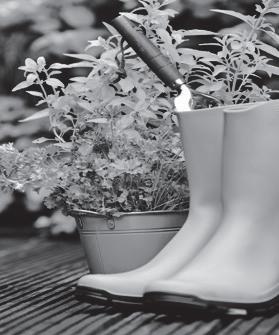
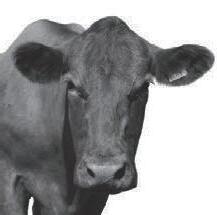






ACROSS
ACROSS
1. Lather
1. Lather
5. Pig’shome
8. Long stick
41. Black 43. Border
27.“God’sLittle __”
46. Authority 47. Attendance
29. Bits of granola
55. “_ House” (song)
56. Small lump
Umbrella



32. Don’tgo
48. Immediately
Is beholden to
Ac tual
Tardy
Tenant ’s concern
Spots
Cheek y
NewEngland cape
Long sandwiches
Larr y, Curly, and Moe
“____ the Woods”
Vicinities
Amount unpaid
thefat
49. Stage prompt
5. Pig’shome
12. Laz y
13. Sheep’s ma
8. Long stick
14. On the road
12. Laz y
15. Borscht vegetable
50. Street entertainer
33. Face themusic: 3wds
54. Mother ’s sister 55. “_ House” (song)
57. Cour tdividers
58. Moistened
13. Sheep’sma
16.Solid
18. Behind
14. On theroad
20. Desert stops
21.Silent
36. Before long 37. Consumes
56. Small lump 57. Cour tdividers
59.Messy fellow DOWN
8. Umbrella 9. Is beholden to 10. Tardy 11. Spots 17. New England cape 19. Smooth 21. Long sandwiches 22. Larry,Curly, and Moe
38.Hot beverage
39.Civil rules
24. Takeson
15. Borscht vegetable
26. Coffee ser ver
16. Solid
27. “God’s Little ”
18. Behind
29. Bits of granola
20.Deser tstops
33. Face the music: 3wds
21. Silent
36. Before long
37.Consumes
24. Takes on
38. Hot beverage
39. Civilrules
26. Coffeeser ver
41.Black
58. Moistened 59. Messy fellow DOWN
43. Border
1. Tall tale 2. Lyricverse
46. Authority
47.Attendance
3. Beerlike brew 4. Copperor nickel
50. Street entertainer
54. Mother ’s sister
5. Denomination 6. Tango requirement 7. Urge
1. Tall tale
2. Lyricverse
3. Beerlike brew
4. Copper or nickel
Denomination
23. “ the Woods” 24. Vicinities 25. Amount unpaid 28. the fat 30. Choirvoice 31. MT Vwatcher, e.g.
Tango requirement
32. Don’tgo 34. Signs up 35. Patron 40. Zooattraction 42. Explosives
Urge
Choir voice 31. MT Vwatcher, e.g.
Fill in the grid so thatevery row, every column and every 3x3 box containsthe numbers 1through 9only once.
Each 3x3 boxisoutlined with a darker line. Youalreadyhavea few numbers to getyou started Remember: you must not repeat the numbers 1through9inthe same line, column or 3x3 box.
51. Notwell
52. Cow’scall
34. Signs up 35. Patron
53. Recede,asthe tide
40. Zooattrac tion 42. Explosives
43. Reach
44. Ac tual
Tenant’s concern 46. Cheek y
Immediately
Stageprompt
Not well 52. Cow’scall
53. Recede,asthe tide
SAGITTARIUS Ta
CAPRICORN
Preparefor awhirlwind of
AQUARIUS
Whether
PISCES
Yo
overallwell-being.




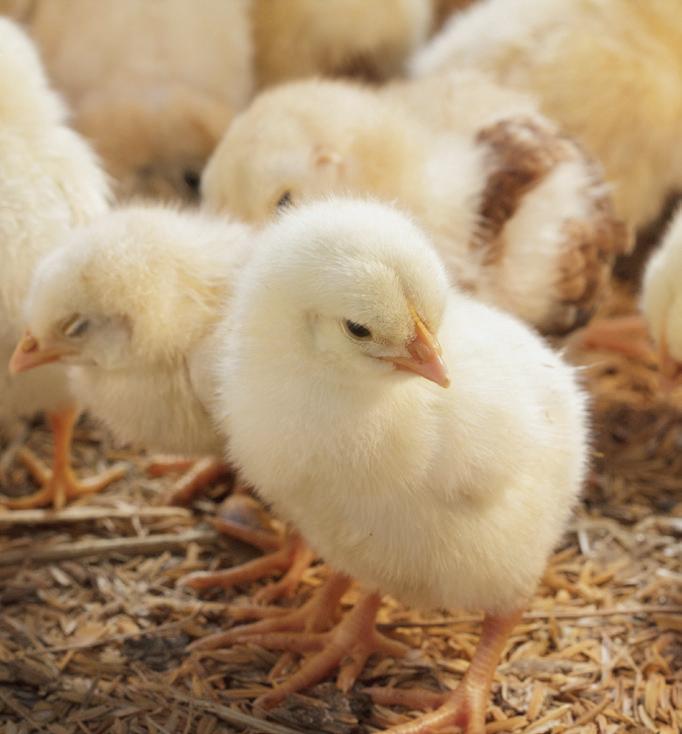





T�a�ks to all of the hardworking men and women of our agriculture industry for all you do!






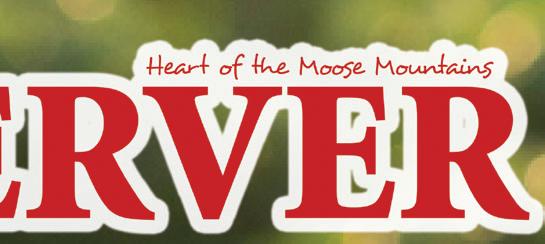




By Stephanie Zoer
Daryl Harrison is well known in the southeast corner of Saskatchewan as being a family man, community man and a farmer.
He is seen being involved in many community events and is not afraid of hard work.
Harrison is first and foremost a family man. He believes that family is the foundation of everything that he does.
Married to Cheryl Harrison and having six children, and seven grandchildren, they farm in the southeast where he was born and raised.
Together they have 160 head of Chianina cattle, a breed known to be larger and having ease of calving. The calves grow quickly and are lean, with just the right amount of marbling with fat.
Farming is a way of life for Harrison, but lately he has been a little busy.
Cheryl is taking care of the farming needs. Her career trade is an RN which has come in handy on the farm, and while Harrison is away, she takes care of the calving, doctoring of cows and anything else that is related to the farm.
Harrison is the Cannington MLA, but last fall he also be-

came Saskatchewan’s agricultural minister.
“Premier Scott Moe called me and asked to have a meeting with me,” said Harrison. “I had no idea at all what the meeting was to be about.”
“I am humbled and honoured when Premier Moe asked me to be the new agricultural minister,” Harrison said.
Lyle Steward was the Ag minister from 2012-2018 when he stepped down due to health issues. David Marit took his place until Harrison received the position.
“These men did excellent jobs, and I have big shoes to fill,” said Harrison.
The role does not require a college degree, but an agricul-
tural background is a big plus, and it is a huge sector.
Harrison has been seen at many functions already, but it is not only farming events that he attends. He makes a point to go to other events.
Recently Harrison, Moe and other delegates from Saskatchewan attended the Winter Policy Conference for the National Association of State Departments of Agriculture (NASDA) in Washington.
The conference offered a unique opportunity to meet state secretaries, commissioners and directors of agriculture, industry leaders and federal representatives to talk pressing agriculture and food policy issues.
Important discussions were the tariffs that President Donald Trump has implemented on Canada, and how this 25 percent tax will raise costs on many things.
Harrison said this will not only hurt Canadians, but it is also hurting many industries in the United States.
Grain and potash are big sellers to the U.S. and these prices will now increase with the tariff, prices at the pumps will increase, food on the tabletop will increase, it is a domino effect.
Saskatchewan has many

resources and they need to be utilized to help the agricultural sector says Harrison.
Lake Diefenbaker was built with Gardiner Dam to help with irrigation. It is their hope to get the existing canals cleaned out and useable, and to secure more water.
“We have the land, heat and water to grow a lot of our things,” said Harrison.
In the meantime, the Farm Show is coming to Regina from March 18-20. It has been moved up from June as farmers are out in the fields haying or possibly seeding crops if the weather is not cooperating.
Harrison will be in attendance and is always available to talk to people.
There is also the Ag in Motion located northwest of Saskatoon in Langham. This is the largest outdoor show in Western Canada and will be held on July 15-17.
Held on 640 acres, they offer live demonstrations of farm equipment, and once again Honourable Harrison will be there, answering questions. Harrison is here to support the producers of Saskatchewan big and small and to move forward with the means that the province has, which he feels is a lot.

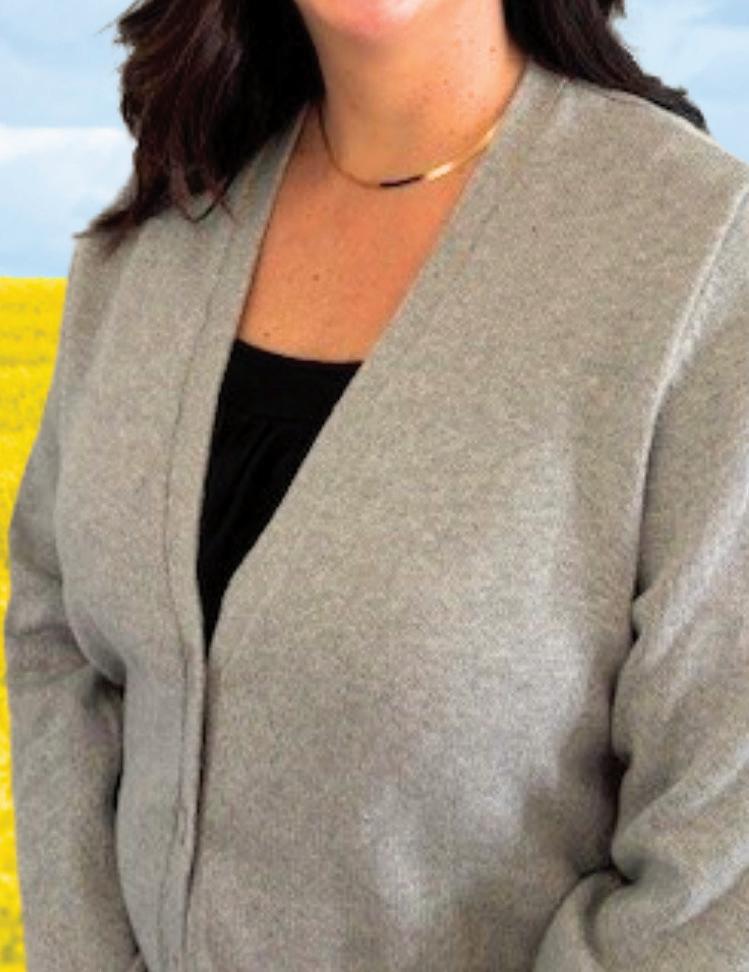



to all of the hardworking men and women of our agriculture industry for all you do!
By Paul Kimball
“These are days of confusion and concern for those working in the agricultural industry.”
Those are the sentiments of Dr. Robert Kitchen, who has been representing the Souris – Moose Mountain riding as a Member of Parliament (MP) since 2015. The riding he serves is home to many farmers and ranchers, as well as workers in the natural resources sector (oil, gas, coal and potash).
In those years as an MP, Kitchen has been a member of the Opposition (the Conservative Party of Canada). He has been a part of various committees, including Veteran Affairs, Health, and Government Operations & Estimates (OGGO). Prior to enter-
ing the political realm, he was a chiropractor in Estevan.
As a chiropractor/politician, he has interacted deeply with those in agriculture and natural resources. In fact, Kitchen likes to use ‘chiropractic language’ in describing these fields. “Agriculture is the backbone, keeping communities together and stable; whereas those in the natural resources are the arms and legs, much more visible than the farmers and ranchers who spend so much time in the field. Both are integral to a community’s wellbeing.”
But these days are increasingly hard to those whose livelihood comes from agriculture. With all the talk of tariffs –the instituting of them and the subsequent withdrawal of them,

Dr. Robert Kitchen,
farmers are increasingly uncertain of what the future holds. According to Kitchen, the confusion and concern stems from the immaturity of
Prairie farmers draw attention to dangers of carbon capture and storage
Aiming to reduce their emissions, oil and gas corporations are looking to carbon capture and storage (CCS) as the solution. CCS works as it is named: CCS captures carbon dioxide (CO2) emissions from industrial production, transporting these emissions through pipelines, and storing them in underground rock formations, oftentimes saltwater aquifers.
the leaders of the United States and Canada. Tariffs are implemented… reciprocal tariffs are put in place…tariffs are withdrawn…what does it all mean?
Kitchen cites an example. A 25 percent tariff has been slapped onto canola. Farmers are wondering, “Will I have a market if I go ahead and plant canola? Do I have to look for various avenues in selling my crop?”
Finding new buyers is not always easy, as there are international and even provincial trade barriers that often have to be overcome. Kitchen also points out that there are 40,000 canola farmers across Canada, and they are all facing these issues!
Being in the southeast corner adds yet another dimension, Kitchen
notes. Many farmers in this area have family and friends on the other side of the border and have spent years working together, despite the national boundary that divides them. The tariff ‘roller coaster ride’ has thrown a wrench into how working together can continue as it has, as the tariffs introduce things that are beyond their control.
As the ‘retaliatory tariffs’ are put in place by Canadian leaders, that also potentially raises the costs of farming – an industry that already has very high costs. Yes, these are tough times for those who work hard faithfully bringing food to our tables. They have the right to be concerned.
And so should all of us!
CCS projects pose a number of risks to human, animal, and environmental health. Pipeline ruptures pose asphyxiation risks from CO2, as well as contamination risks from toxic chemicals such as hydrogen sulfide, which is carried alongside CO2. Concerns also have been raised about CCS storage facilities leaking and leading to dissolution of CO2 into groundwater. The dissolution of CO2 in water creates carbonic acid, which is unsafe for both humans and livestock.
cultural significance.
“Geological carbon capture and so-called ‘storage’ is no solution at all to climate change,” says NFU Board Member Glenn Norman. “Nearly all attempts to date have failed and leaked to the surface contaminating both ground and surface water.”
Under pressure from a coalition of farm groups, the Queensland Government in Australia has banned CCS projects in the Great Artesian Basin, the country’s largest groundwater basin, in order to protect its environmental, agricultural, economic, and
Members of the National Farmers Union adopted the following resolution at the NFU’s National Convention last November: “[the NFU] opposes the use of CCS projects to extend the social license of fossil fuel corporations to continue with their


‘business-as-usual’ operations.” While CCS is touted as a climate solution, 70% of U.S. pipelines transporting CO2 are used for enhanced oil recovery - using captured CO2 to pump more oil and gas out of wells. The resolution also opposed the use of public money to support industrial CCS projects.
The NFU, in collaboration with other groups, is focusing its attention on the Cold Lake CCS Project.
The NFU is in solidarity with local agriculture groups and First Nations who are working in opposition to the Cold Lake CCS Project.
The NFU also demands that the Federal Government complete an Impact Assessment on all sections of the Cold Lake CCS Project, as the Government of Alberta has refused to do so.
“Carbon Capture aids and abets the priorities of the oil and gas sector, which prioritises unsus-
tainable extraction and exploitation. In solidarity with farmers and the Indigenous peoples affected by the Cold Lake CCS Project we must understand that is not in their interests. When we make connections to what Albertans have endured: the droughts, the wildfires, the smoke and poor yields, to the risks of CCS, it is clear that the Cold Lake Project does not benefit us.” Says NFU Youth President Adama Bundu.




By Kaitlynn Nordal
Agriculture in the Classroom SK started in 1994.
This partnership provides high school students with a hands-on experience exploring career opportunities in agricultural technology and food production.
“Since then, we have been developing educational resources and programs for students and teachers across Saskatchewan,” said Sara Shymko Executive Director of Agriculture in the Classroom SK. “Our focus is to provide opportunities for students to connect with agriculture and the people who are growing their food.”
“The goal is that they care about agriculture, know more about their food, how it’s grown, but also choose to support agriculture in different ways, (and maybe) pursue careers in the industry,” continued Shymk.
Agriculture in the Classroom SK also ran career expos at Agribition for years.
“In some of the conversations we have been having with the Cornerstone Credit Union they
are interested and supportive of the ag tech industry growing,” said Shymko. “They see the opportunities that are there.”
This then made them interested in bringing some of the programming to the Yorkton area.
“Knowing that they had a focus in technology and agriculture (and) we already had a model that worked well for career promotion we married the two,” said Shymko.
The event in Yorkton will be a similar model to previous career expos with industry professionals and experts in agriculture participating with 15-minute stations that high school students rotate through and participate in various activities.
“They get to talk to people who are working in these different industries and different types of jobs,” said Shymko. “The overall goal is to give students a window into the different opportunities that exist in the ag industry.”
The focus of the event will be on the technology used in agriculture and the different opportunities and careers.
“(They will) see the opportunities that are out there in the industry for tech and how important it is in all types of farms and within the industry,” said Shymko.
“Lots of students don’t realize maybe the coding class can lead to an opportunity in agriculture or mechanics and how tech plays a role in that,” said Shymko. “We wanted to take the opportunity to open student’s eyes to how much tech is out there in the world. There is all this tech around them but they don’t necessarily see the opportunity for careers in tech and ag world.”
The upcoming AgTech Expo, will take place on April 2nd and 3rd in the Gallagher Centre from 9:30 to 2:30 Yorkton.
The AgTech Expo was designed to introduce students to cutting-edge agriculture technology.
Shymko is expecting this to be a big event.
“We are hoping to have 800 to 1,000 students rotate through in the two day,.” said Shymko.
This event is months in the making with the planning starting in October.



“Over the last couple of months, we were able to secure the partnership,” said Shymko. “Cornerstone has come on as a sponsor. They are involved both in providing financial support but also opening some doors for us reaching out to some of their contacts.”
“I think this is more than a sponsorship for them because they believe in the opportunities that are out there in the agriculture world for tech. It’s been a wonderful partnership,” said continued Shymko.
Holding the event in Yorkton was an obvious choice.
Yorkton is a hub for ag within that area. We have a lot of schools and teachers who are excited to have this opportunity for their students,” said Shymko.
Teachers can expect their students to have a hands-on day outside the classroom learning about topics such as Soil Testing, Biotechnology, and Animal Science.
“Teachers can expect their students to be engaged throughout the day as they navigate and participate in a hands-

on activity meeting people in the industry,” said Shymko.
No matter their interest there will be something for every student.
“Students can expect to learn something new that maybe piques their interest in terms of choosing or exploring further careers,” said Shymko.
“I feel confident some of the students will even be encouraged to follow
through and pursue a career in ag,” continued Shumko.
There is going to be everything from drones, to equipment, to cameras, and everything in between.
“There is going to be a lot of different and unique things out there,” said Shymko. For more info contact program coordinator Lindsey Rudd on lindsey@aitc.sk.ca.




SouthEastResearchFarmexiststomakefarming more profitable, sustainable, andresilient by providingrelevantresearch, technicalknowledge andresources
Lana Shaw,BSc,PAg, ExecutiveDirector www.southeastresearchfarm.org seresearchfarm@gmail.com


By Stephanie Zoer
Darren Ippolito and his spouse Kylie McRae, along with their three children, Kord their eight-year-old son, Etta who is their seven-yearold daughter and their five-year-old daughter Ray-Lynn call Moose Creek Red Angus farm their home, which has been in the family since the early 1900’s.
The land was purchased by Ippolito’s great grandparents Alvarito and Laura Ippolito.
In 1949 Ippolito’s grandparents Raymond and Betsy Ippolito began to build on the land. Their son Glenn Ippolito and his wife Donna ran the farm with Glenn’s parents.
The farm’s name Moose Creek Red Angus was formed in the 1970’s and has held the name ever since.
Darren returned from college in 2001 after getting his Agricultural Production degree in Olds, Alberta and he went full force into farming.
Today Darren and his family run the farm, and his children are the fifth generation to enjoy the farm life.
Kylie also works on the family farm but has a job with Ducks Unlimited as a Rangeland agrologist and has received many awards for her outstanding work and recognition of service with the company.
Their farm is located south of Kisbey, and it
runs 500 head of cows, and they are all registered red angus cattle.
With a herd this size they need 25 bulls to service the cows, as each bull usually breeds 20-25 cows.
“Bulls can breed more than this, but this is how we do it,” said Darren.
They can not do all the work themselves and have two employees. Max Gauthier is the cow boss, and he takes care of the herd health, including needling, tagging calves, and feeding. While Tanis Palmer is the lead operator and she runs the equipment, does the feeding as well, and they both do whatever it takes to make the farm run smoothly.
To feed a herd of this caliber it takes 3000 large bales of hay. Each cow will eat two and a half metric tons during the winter. “Younger stock will eat less,” said Darren.
They harvest as much feed off of their own land which includes hay and silage or referred to as roughage.
It is calving season at Moose Creek and on any given day they can have 10-12 calves. With a video monitor in the house, they can see the calving pens and watch as a cow calves. If a problem comes up, they can easily go to the pens.
The calving pens are checked several times a day and night to ensure everything runs smoothly, and the herd

is checked as well, in case a cow is closer than they anticipated.
This year they have had several sets of twins. This is not something that farmers want, as usually the calves are smaller and at times the cow will reject one calf.
To grow their own herd, they keep their own heifers, which has a higher degree of keeping records and they can grow the herd through their own genetics.
They also keep bull calves, and when they are a year and two years old, they are sold for breeding. This sale is coming up on the farm April 14 with 90 bulls on the sale list.
They had not shown any cattle since 2009, and for 15 years worked on customer service.
In 2023 their bull Vi-
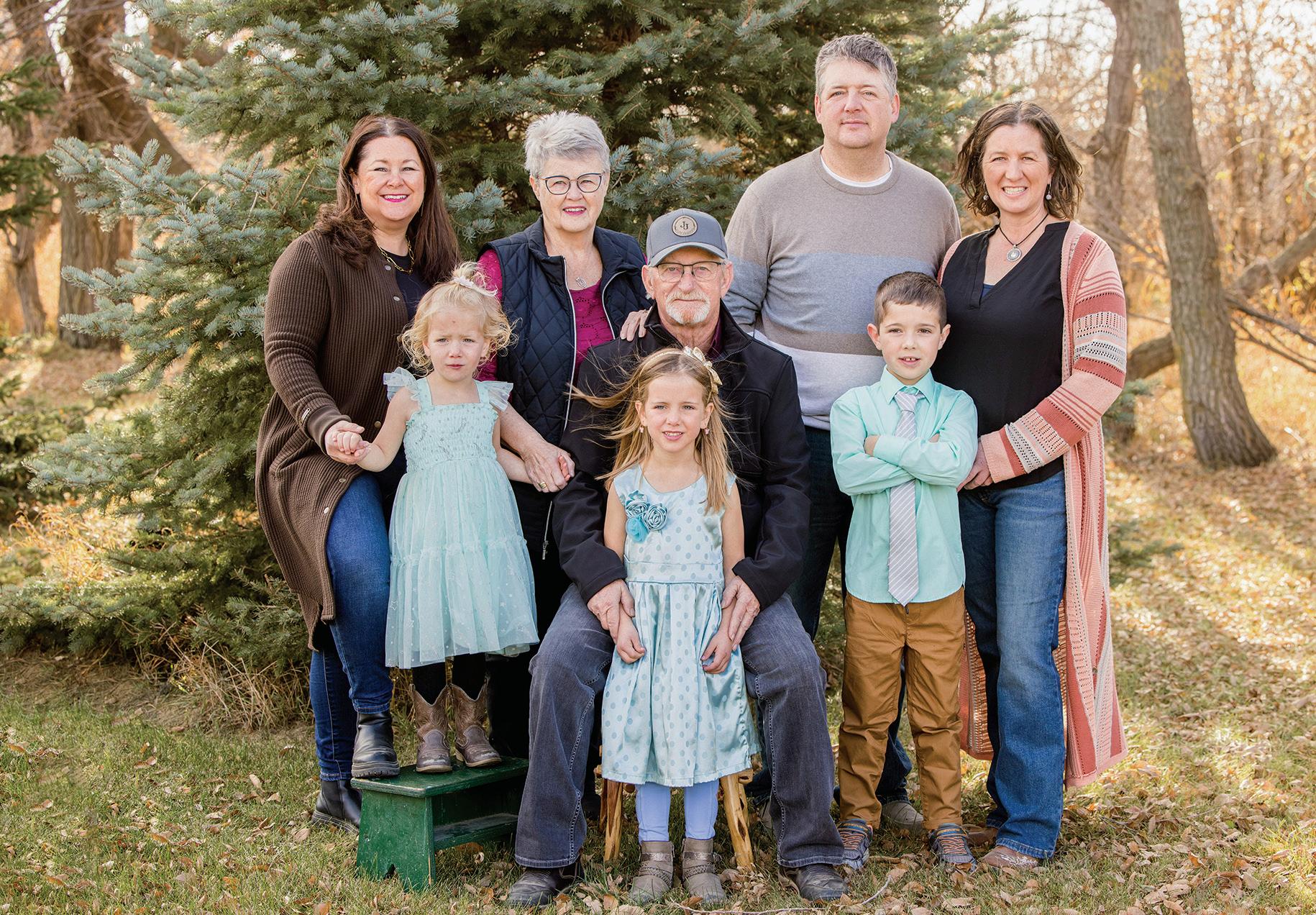
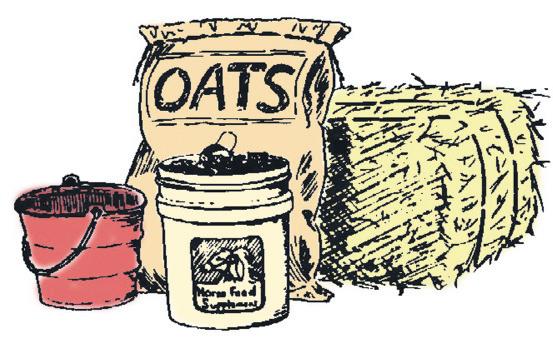
per became the Canadian Reserve national champion, and in 2024 Viper became the Reserve Champion Bull at the National Western Stock show in Denver. Viper remains on the farm.
“This is our business,” said Darren. “It is what we do, and we love it. Farming is our life.”



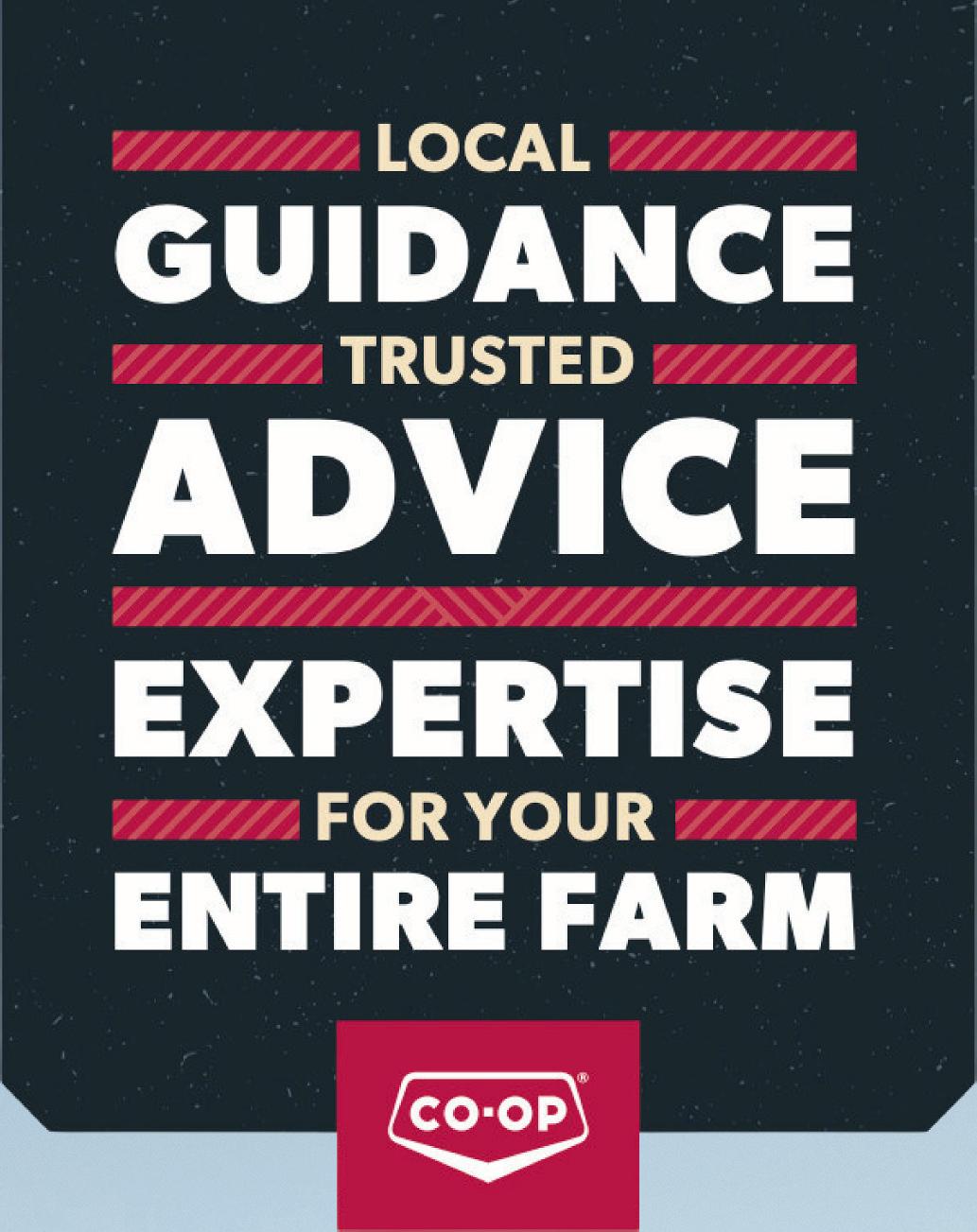

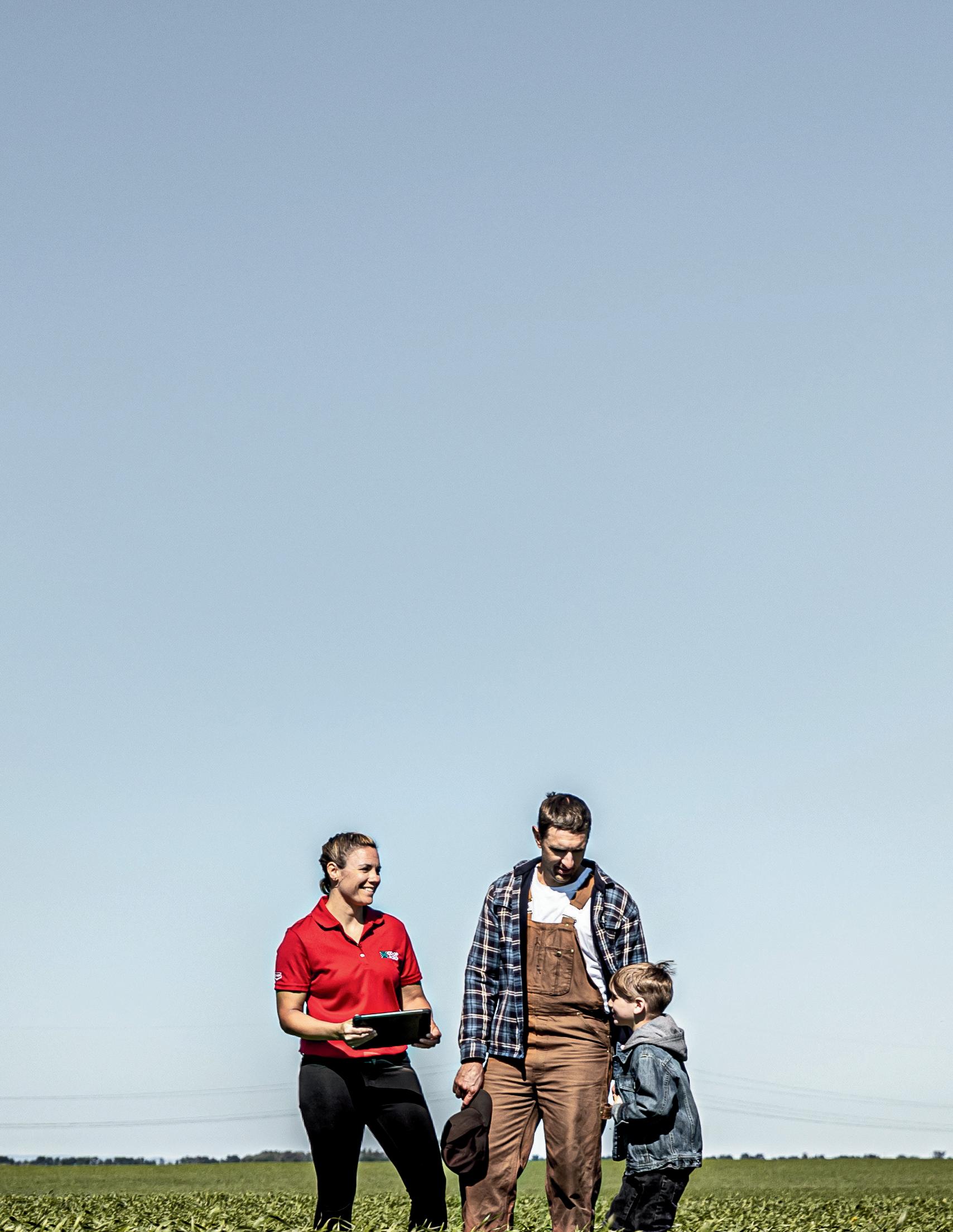




T�a�ks to all of the hardworking men and women of our agriculture industry for all you do!
By Stephanie Zoer
Equipment is one thing that farmers and acreage owners need to make their lives easier, whether it be a larger sprayer for the land or a smaller tractor and blower to clean snow, this is where Nelson Motors and Equipment comes in to play.
Wally Nelson bought his first dealership in 1959 in Avonlea, and it was already a John Deere. Over the years the company grew with adding locations in Radville, Estevan, Redvers and Oxbow.
The business has been family owned and operated ever since. Nelson’s brother Gary Nelson joined the team around 1969.
In the past ten years Gary’s son, Jarret Nelson and Gary’s daughter Terri Stevens and her husband Marlyn Stevens have also joined in the family business.
Darcy Yergens, who is branch manager and
Equipment sales, is also part of the large team, with Nelsons employing approximately 150 people.
Yergens has worked for Nelsons since 2022 this time around. He worked for Nelsons from 2010 to 2015, and then moved to Kelowna where he sold John Deere, returning home to Saskatchewan in 2022.
Yergens just returned from a business trip to Iowa with 40 customers, where they had a tour of the John Deere factory.
During this time, they also had the opportunity to visit the John Deere museum and visit the parts plant that covers 65 acres.
John Deere has their own cast to make the parts for their equipment, so they have control over how the parts are made.
With technology always improving John Deere is working on having tractors, combines and sprayers that will soon be able to operate without a driver. These
pieces of equipment should be on the market in the next year or two.
Yergens said that farmers have such a narrow window with field work because of the weather, they want to ensure they get this farm work done in a quick and efficient manner and feels the equipment that they have will do that job.
They have many competitors but according to Yergens, John Deere is the market leader in every segment.
They do not only carry John Deere but have a wide range of locally produced products.
Brandt, Bourgault, Schulte, and Seed Master are all made in Saskatchewan, and Macdon Industries is from Manitoba. Macdon is responsible for headers on equipment such as combine headers.
“With the tariff ’s coming into play, this is going to cause major issues,” said Yergens.
For example, a piece of farm equipment that will

cost $1million dollars will now cost the potential buyer an extra $250 thousand dollars for the 25 percent tariff.
Not only is it the tariffs but the market for grains has gone down as well and every farmer is feel-
ing this.
Yergens feels that buying new equipment may not be in the budget for many farmers this year due to the increase of costs across the board.
The tariffs will be applied to most agricultural needs, and it is their hope that this is short lived. In the meantime, they will continue with excellent customer service and look forward to serving farmers with all their equipment needs in the years to come.
Daryl Harrison Saskatchewan Agriculture Minister
The Ministry of Agriculture has amended the Crown land grazing lease rate formula, effective for 2025.
The revisions to the grazing formula will offer relief to producers rent-
ing Crown land and contribute to affordability and stability for the livestock sector in the face of rising production costs. Amending the rental formula provides a transparent and straightforward calculation for producers to understand while increasing the stability and predictability









of the annual rental rate.
“We have listened to feedback from producers and, as a result, these changes will contribute to the further growth of the province’s livestock sector,” Agriculture Minister Daryl Harrison said. “Additionally, this new formula provides a fair and transparent pricing

structure for producers and a fair return for a public asset back to Saskatchewan taxpayers.”
“We have been requesting changes to the formula for a while and are pleased where the province has landed,” Saskatchewan Cattle Association Past Chair Keith Day said. “The 20 percent ceiling on fee increases will help producers and community pastures better plan for
any possible changes to the rates.”
In 2024, the ministry conducted consultations with livestock producers and industry associations to determine what changes to the grazing formula would provide more predictability for producers. As a result, the ministry has introduced an amended formula that uses price averaging of cattle marketed between October
1 to November 30 of the five preceding years, as opposed to the previous formula based on fall cattle prices from the previous year.
The ministry also introduced a 20 percent cap on annual rental rate increases. These changes ensure rates are less vulnerable to sharp fluctuations and provide more stability to help producers budget for the coming year.






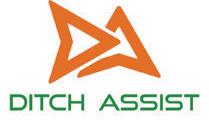










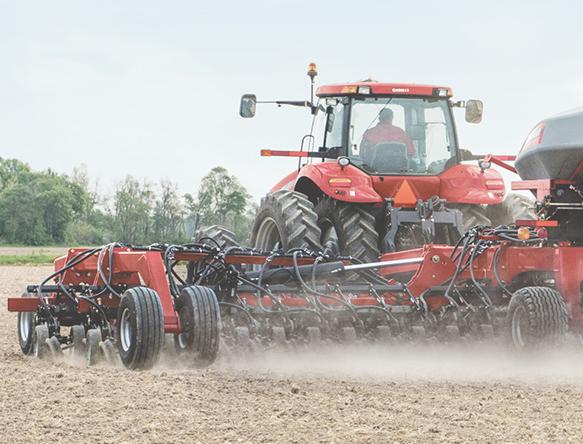








By Stephanie Zoer
The Stoughton Feed Processing plant is located on highway 13 just east of the town of Stoughton where it employs six full-time employees and two students.
John Sponheimer has been part of the feed mill team for one and a half years and moved here from B.C. with his family.
He spent 34 years in Alberta, five years in Tisdale and eight years in B.C. before making Stoughton his home.
Processing feed is not simply unloading a semi of durum wheat and putting it in a bin, there is a detailed and delicate process to making feed.
This mill is dedicated to serving the agricultural community and specializes in producing high quality feed mixes for various livestock, including cattle, swine, and chickens.
Most chicken farms are located in Ontario and B.C., with the majority of livestock in Saskatchewan being hogs and cattle, but bison are seen more all the time.
Sponheimer emphasizes that quality and precision is of the utmost importance.
They begin their feed production process by sourcing premium grains, and meals, such as corn, barley, durum wheat, soya meal and distilled corn, which are then meticulously mixed to create a nutritionally balanced feed to meet the specific needs of different animals.
This commitment ensures that livestock receive the essential nutrients required for optimal health and productivity.
Sponheimer has a background in feed mill work and is a hands-on kind of guy.
When a semi comes into the plant with an ingredient the truck is unloaded at the south side of the mill and placed in the holding bins, this is were it stays until it is needed. A sample of composite is taken to the lab, so they know the quality of the ingredient.



From there it is transferred to the inside bins and weighed. It is once again moved to the mixer, with the proper amounts of soya, limestone, grains, and micro ingredients.
It is mixed into a mash feed and can stay in this form or be made into pellets.
Trucks are loaded with the completed feed on the north side of the mill.
Each bin of feed made must have a certain amount of protein, fiber, and minerals and usually have 50 percent corn for carbs and each batch is tested for such.






It is critical that the feed have certain percentages of each item that is added to be the proper portion for bone growth and muscle strength in the animals.
Each bag of feed is labeled with the contents of ingredients just as it is done for humans with food labels.
To make two tons of feed takes approximately 20 minutes, pellets take a little longer and most feed delivery trucks can hold 27 tons.
Presently, 65 percent of the feed made at the mill goes to Pig Improvement Company (PIC) south of Carlyle
and 25-30 percent of feed made is delivered to Hypor north of Kisbey.
On the average, six semi loads of feed are delivered daily to the farms by Goudy Transport, LNW and LIM trucking companies. Nine loads of feed are made daily, which is over 200 tons per day.
A trip to Hypor can take five hours round trip which is usually taken care of by LNW or LIM.
Sponheimer said they do their best to source seeds that are grown by local and area farmers as they want to promote local as much as possible.













T�a�ks
to all of the hardworking men and women of our agriculture industry for all you do!
ByJackson Lees, Club Reporter
On February 20th our club had our Speech Day at the Arcola Legion. All 4-H members were in attendance, except Matthew Charlton.
The judges for the day were Chantel Baerle and Billy-Jo Kohler - thank you for taking the time out of your day to join us. The members’ speech topics were: Hannah Lees - “All about Cats”; Jackson Lees - “History of Cattle”; Lexi Foy - “What I did this past year”; Nyia Pretty - “How recycling helps us”; Becca Lees - “Mental Health in Sports”; Jade Charlton - “Just Stand Up”; Andrew Charlton - “Rock, Paper, Scissors”; Bode Pretty - “The Weather”; Kyla Lees - “Kindness”; Emma Lees - “How 4-H Influenced Me”; Quinn Anderson - “Snow Days”; Morgan Anderson - “Thanks Dad”; Cade Dayman - “My Quad”.
The winners were:
Cloverbud: 1st - Josie Lees, 2ndQuinn Anderson
Junior: 1st - Hannah Lees, 2ndMorgan Anderson
Intermediate: 1st - Becca Lees, 2ndLexi Foy
Senior: 1st - Emma Lees, 2nd - Jade Charlton
After the speeches we had a 4-H meeting where we talked about our Wildlife Banquet Fundraiser Clean-Up on April 6th. We also talked about how we have our drop and go at Sarcan now. If anyone has any recycling they would like picked up by one of our members,
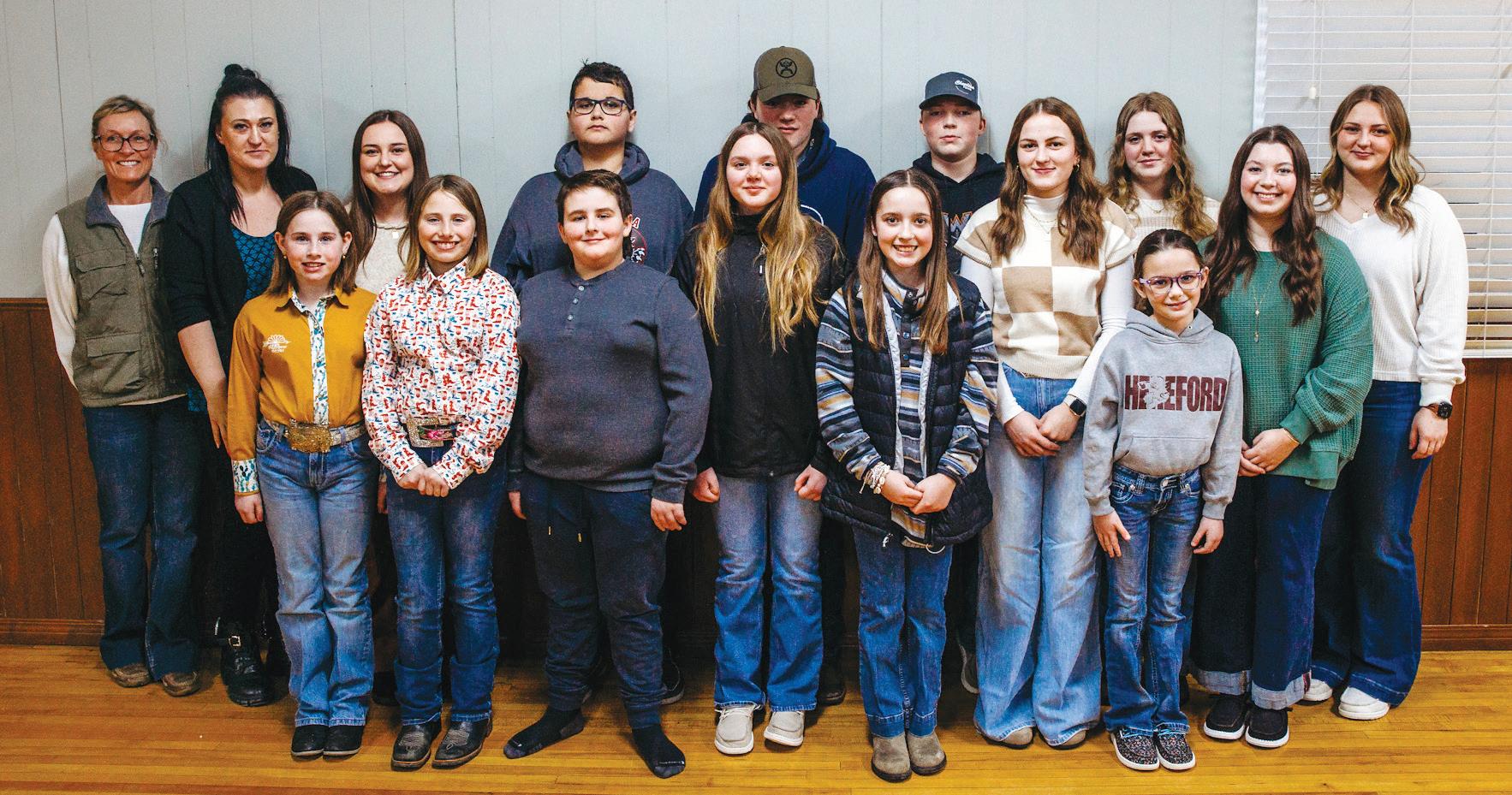
give Jackson Lees a call at 306-5771375. We then talked about setting up our next meeting at Pretty Farm for a presentation from Sarah Leguee. We have two coat and pants sponsors confirmed: Kingston Midstream and JJ Trucking. We are looking for a couple more of those so we can get them ordered for our members.
On March 1st, Josie Lees and Han-
nah Lees represented our club at District Speeches, in Weyburn, with Josie placing 2nd overall in Cloverbuds.
On March 9th, we had our project meeting with Sarah Leguee at Pretty Farm where she talked about social media and marketing agriculture. She gave us a lot of advice on the subject and our members enjoyed welcoming her to our meeting - thank you
Sarah. We then had a meeting with the members that were in attendance where we discussed possibly doing our next meeting while doing a tour of the Butchers Block in Alameda. Sarah Anderson is going to contact them to set that up for us in April. We also talked a little about Achievement Day and starting to think about judges for that.
With the imposition of U.S. tariffs on Canadian goods, eight Saskatchewan farm groups are joining forces to host a Saskatchewan Ag Summit in Saskatoon on March 27. This collaborative event will bring together producers, industry experts, and stakeholders to focus on critical issues facing the province’s agricultural sector, including farm advocacy efforts and mounting trade concerns.
Bill Prybylski, APAS


President, emphasized the importance of this collaboration, stating, “The Summit underscores the critical role of agricultural organizations during these uncertain times. Issues like the start of U.S. tariffs showcase our vulnerabilities, highlighting the need for greater awareness and preparedness.”
Summit presenters include:
• Canadian Agri-Food Policy Institute: Delivering a comprehensive overview of agri-food challenges, insights into trade risks and disruptions, and highlighting strategic policy direc-
tions for navigating an increasingly complex global landscape.
• Agri-Food Economic Systems: Discussing modern approaches to grain contracts and the broader implications of trade challenges.
• Temple Scott Associates: Offering expert guidance on enhancing agricultural advocacy and its role in shaping policy.
• University of Calgary: Exploring emerging trade dynamics and future industry trends.
• Canadian Association of Agri-Retailers: Analyzing how international trade policies affect farm

inputs and the agricultural supply chain.
• Saskatchewan Trade and Export Partnership: Examining the role of Saskatchewan’s agrifood exports amidst global trade uncertainties.
• Mercantile Consulting Ventures: Assessing how increased transparency in export sales data could influence farm profitability and economic stability.
“This Summit is a crucial opportunity for Saskatchewan’s agricultural community to come together, share insights, and chart a course forward on pressing issues,” highlighted Jake Leguee,
Chair, Saskatchewan Wheat Development Commission.
“Having experts from University of Calgary, the Canadian Association of Agri-Retailers, CAPI, and the Saskatchewan Trade and Export Partnership enriches this event with insights and expertise for managing the impacts of trade uncertainty,” said SaskPork Chair, Toby Tschetter. “By joining forces, we’re focused on safeguarding our industry, tackling trade hurdles, and charting a course for continued growth for Saskatchewan’s agricultural community.”





Apr. 26 - Small Animals & Bird Sale Redvers
May 24 - Auction Sale for the Estate of Trevor Hall - Estevan
June 7 - Auction Sale for Randy & Susan Olney - Bienfait
June 11- Farm Action Sale for Wand a Cunningham - Redvers, SK
June 22 - Moving Sale & Carpenter Shop Close -out for Warren & Lynd a BlackstockGladmar, SK






















There isn’t quite as much furor surrounding the renewable diesel and sustainable aviation fuel sectors of late, according to an expert.
“Growth has certainly slowed from the heyday of 2018, 2019 and 2020 when it seemed like there was a project a week,” Jim Lane, publisher of Biofuels Digest, said in a recent webinar.
There are 23.7 billion gallons of planned capacity that have been announced around the globe.
While that is an impressive number, the rate of expansion is slowing. It is up only three per cent from 2024 levels.
However, there is still plenty of interest in the sector with companies like Neste Oyj, World Energy, SPG Bioenergy and Diamond Green Diesel committing to projects boasting billions of gallons of production.
“It’s not quite petroleum scale but certainly getting to a very interesting level of capacity,” Lane said in a webinar promoting the Advanced Bioeconomy Leadership Conference 2025.
Major players like Shell, BP and Marathon Oil Company are making investments despite some of the headwinds facing the industry.
The U.S. Energy Information Administration is forecasting that the West Texas Intermediate crude oil price will drop to about US$60 per barrel by 2026, which would be about half the level it was in 2022.
“That’s going to make a more challenging competitive environment for renewables,” he said.
Lane believes that
T�a�ks to all of the hardworking men and women of our agriculture industry for all you do!

price forecast has a lot to do with U.S. President Donald Trump’s election promise to, “drill, baby, drill.”
In the meantime, actual production of biodiesel and renewable diesel in the U.S. is a fraction of what is being proposed.
Production is expected to reach about 350,000 barrels per day in 2026, well short of the planned capacity of about two billion barrels per day.
The main reason for that underwhelming performance is the U.S. Environmental Protection Agency’s disappointing renewable volume obligation (RVO) targets for 202325, which were set well below industry expectations.
The EPA also has a habit of dragging its feet on announcing the next round of RVOs. It is expected to finalize the 2026 RVO in December 2025, more than a year after its statutory deadline of November 2024.
That makes it difficult for companies to deploy capital, said Lane.
He said the market driver for bioeconomy projects has swung to
sustainable aviation fuel, carbon and hydrogen from renewable diesel.
Lane expects 2025 to be a “tipping point” for biofuel projects. Fiftynine countries have set net-zero targets. Those countries account for 54 per cent of global greenhouse gas emissions.
There is talk that some of those countries are going to back away from their net-zero targets starting in 2025.
However, he noted that biofuel policy is also set at the state level in the United States, with California, Oregon, Washington and New Mexico already having low carbon fuel standards in place. Five other states have active bills in the works and three more are considering legislation.
Some of those same states are pushing policies that promote electric vehicles over renewable diesel.
However, Lane noted that the American Transportation Research Institute recently released a report showing that renewable diesel emissions for heavy duty trucks are half that of electric trucks.


mandate and any unfair subsidies and other market distortions that favour electric vehicles over other technologies.
It orders heads of all government agencies to eliminate policies and procedures that impose an undue burden on the development or use of domestic energy sources.
of 2035, but it looks like that initiative could also be “clawed back,” said Lane.
Trump recently signed the Unleashing American Energy executive order that eliminates the electric vehicle
The biofuel sector originally worried that the Trump administration would favour oil over biofuel, but Trump’s order pertains to removing barriers for both types of fuel, as well as natural gas, coal, hydropower, critical minerals and nuclear energy.
California was going to stop selling non-electric light duty vehicles as
On the feedstock front, he noted that agricultural feedstocks account for 162 of the 691 million tonnes of the annual supplies of feedstock in the near-term. Most of the remainder is forestry/wood and agricultural residues.
There is a huge shortfall of fats, oils and grease feedstock, with only three million tonnes available.
“That has been a real constraint for things like renewable diesel,” he said.
The industry will likely have to shift to using more forestry/wood and agricultural residues.


















T�a�ks to all of the hardworking men and women of our agriculture industry for all you do!
Submitted by USask Media Relations
In a move to strengthen research into crucial livestock production systems, Dr. Flavia van Cleef (PhD) has been appointed as the new Beef Industry Integrated Forage Management and Utilization (IFMU) Chair at the University of Saskatchewan (USask).
As the industry chair, van Cleef will bridge disciplinary boundaries, lead systems-based forage and pasture management, and utilization research to address the needs of all levels of the agricultural sector.
“Working with researchers, industry and producers, Dr. van Cleef will develop innovative tools and resources to improve for-

age management and use,” said Dr. Angela BedardHaughn (PhD), dean of the College of Agriculture and Bioresources at USask.
“We are excited to have Dr. van Cleef join the college to deliver the collaborative, interdisciplinary research needed to support a sustainable livestock and forage sector.”
Forages are plant systems that act as highquality livestock feed with potential benefits for soil health, carbon sequestration, and biodiversity.
Established to address a gap in forage research, the IFMU chair will explore the soil-plant-animal interface to help maximize the agronomic, economic and environmental benefits of forages.
“Productive pastures and forage crops are key to maintaining a strong and competitive beef industry in Canada,” said Craig Lehr, the Beef Cattle Research Council (BCRC) chair and Alberta beef producer. “The investment Canadian producers have made to establish the chair in IFMU will contribute to improved forage and grazing management strategies as well as training of new
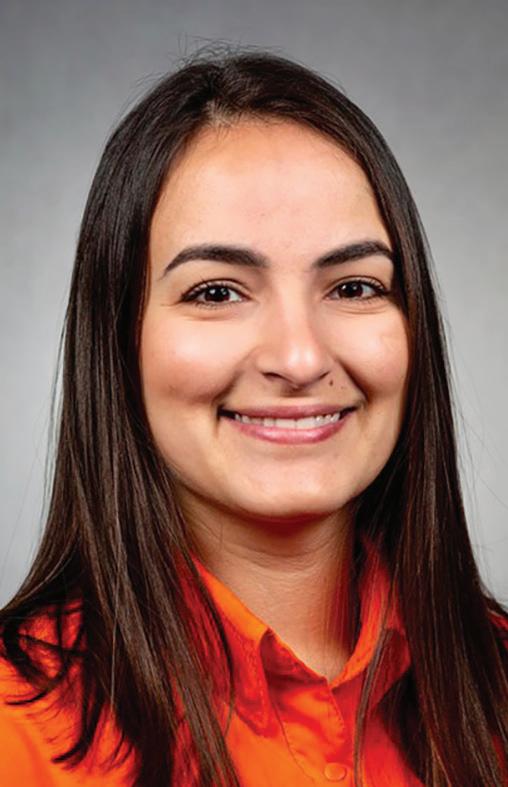
Dr. Flavia van Cleef (PhD) is the new Beef Industry Integrated Forage Management and Utilization Chair at the University of Saskatchewan. Photo courtesy USask
expertise to serve Canada’s beef cattle and forage sectors.”
van Cleef joins USask’s College of Agriculture and Bioresources with a joint appointment between the Department of Plant Sciences and the Department of Animal and Poultry Science. As the industry chair, she will work to advance forage utilization by enhancing system health, productivity and resilience.
“My goal is to bring together the latest research and practical solutions
that work in the real world, ensuring they are locally relevant and aligned with global sustainability demands,” said van Cleef.
“Identifying new technologies through applied research will be key to improving forage use and, therefore, profitability in forage-based livestock production systems. Through collaborative research, I am committed to helping the agricultural community adopt innovative strategies for a more sustainable integrated forage management.”
van Cleef completed her bachelor’s and master’s degrees in animal science at São Paulo State University – UNESP in Brazil. In 2021, she obtained a PhD in agronomy from the University of Florida.
Prior to joining USask, van Cleef was a post-doctoral research fellow at the Center for Nuclear Energy in Agriculture at the University of São Paulo in Brazil. Her studies focused on evaluating the greenhouse gas production of various arid and semi-arid tanninrich plants.
For her research at USask, van Cleef will focus on the develop-
ment and evaluation of agronomic strategies that optimize forage establishment, yield, quality, and longevity. She will also explore feeding and grazing strategies that optimize animal performance while also contributing to improved soil health and environmental sustainability.
The industry chair position is jointly funded by the Beef Cattle Research Council, the Saskatchewan Cattle Association, the governments of Canada and Saskatchewan through the Sustainable Canadian Agricultural Partnership (CAP), and the Global Institute for Food Security at USask.
Sustainable CAP is a five-year, $3.5 billion investment by Canada’s federal, provincial and territorial governments that supports Canada’s agri-food and agri-product sectors. This includes $1 billion in federal programs and activities and a $2.5 billion commitment that is cost-shared 60 per cent federally and 40 per cent provincially/territorially for programs that are designed and delivered by provinces and territories.
